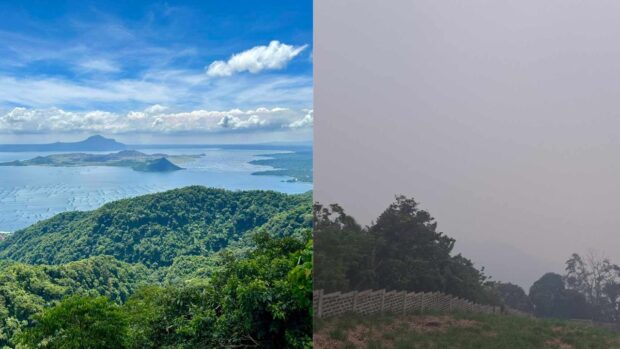
BEHIND THE SERENITY Taal Volcano looks serene in this photo taken from Tagaytay City on Sept. 25, but it continues to emit harmful volcanic smog that has shrouded the volcano (right), shown in this photo on Sunday, prompting local governments in Batangas, Laguna and Rizal to suspend classes on Monday. —PHOTOS FROM THE TAGAYTAY CITY TOURISM OFFICE AND EVELYN GONZALEZ
LUCENA CITY—Following Taal Volcano’s sudden heavy emission of volcanic sulfur dioxide (SO2) gas on Sunday, in-person classes in public and private schools in parts of the provinces of Batangas, Laguna and Rizal were suspended on Monday to ensure the safety of students and teachers.
The Regional Disaster Risk Reduction and Management Council (RDRRMC) and the Office of the Civil Defense in Calabarzon (Cavite, Laguna, Batangas, Rizal, Quezon) announced the suspension early Monday.
Local authorities in the areas affected by “vog,” or volcanic smog, ordered the temporary shift to online or modular classes.
The spread of the thick volcanic smog reaching as far as Laguna was attributed to wind directions and high level of emission that reached up to 2,400 meters on Sunday, the RDRRMC said.
In Laguna province, the local governments in the cities of Biñan, Sta. Rosa, Calamba and San Pedro suspended on Monday in-person classes in public and private schools in their respective localities. Local authorities ordered the shift to modular or distance learning.
The agency also announced the suspension of classes in public and private schools in the towns of Angono and Taytay in Rizal.
In Batangas, only six localities had suspended classes in September due to the vog. This time, class suspension were ordered in the towns of San Jose, Balete, Ibaan, Balayan, San Nicolas, Calatagan, Sta. Teresita, Agoncillo, San Pascual, Bauan, Lemery, San Luis, Alitagtag, Nasugbu, Rosario, Mataasnakahoy, Malvar, Lian, Tuy, Taysan, Lobo, Laurel, Padre Garcia, Taal, Cuenca, San Juan and Mabini; and the cities of Batangas, Calaca, Sto. Tomas, Tanauan and Lipa.
Irritating
Evelyn Gonzalez, a resident of Tagaytay City in Cavite province that overlooks Taal Volcano, said the vog suddenly enveloped their surroundings on Sunday afternoon.
“Taal Lake and the volcano were covered by thick smog. The smog is irritating to the eyes and throat,” Gonzalez said in a phone interview on Monday.
However, Tagaytay City was not among the local government units that suspended classes.
Vog consists of fine droplets containing volcanic gas such as SO2, which is acidic and can cause irritation of the eyes, throat and respiratory tract, with severities depending on the gas concentration and duration of exposure.
Mask up
Health authorities warned that people who may be particularly sensitive to vog are those with health conditions such as asthma, lung disease and heart disease, the elderly, pregnant women and children.
Health and local officials reminded their residents to wear face masks, preferably N95, when going out of the house for protection against SO2 plumes from the volcano.
The Department of Health in Calabarzon, in an advisory, urged the residents in the affected areas to be cautious and stay protected against the high levels of SO2 emissions from Taal Volcano.
“As much as possible, stay indoors. Wearing a face mask can also be very helpful if needed,” it added.
The Philippine Institute of Volcanology and Seismology (Phivolcs) reported that volcanic smog has been affecting the areas surrounding Taal since the first week of September as an average of 3,402 tons per day of SO2 had been degassed from the volcano last month.
Some towns surrounding the volcano reported that some of their students got sick due to vog inhalation.
On Oct. 6, the state volcanologist reported emissions of 6,051 metric tons (MT) over the past 24 hours that rose to 900 m above Taal Volcano Island, which nearly doubled the recorded figures on Oct. 4, which was 3,465 MT of SO2.
In its 5 a.m. bulletin on Monday, Phivolcs said emissions had dropped to 2,887 MT. However, the emissions reached 2,400 m tall and drifted in the west and southwest directions, reaching Laguna province.
Taal Volcano remains under alert level 1 (low level of volcanic unrest), according to the state volcanologist. INQ